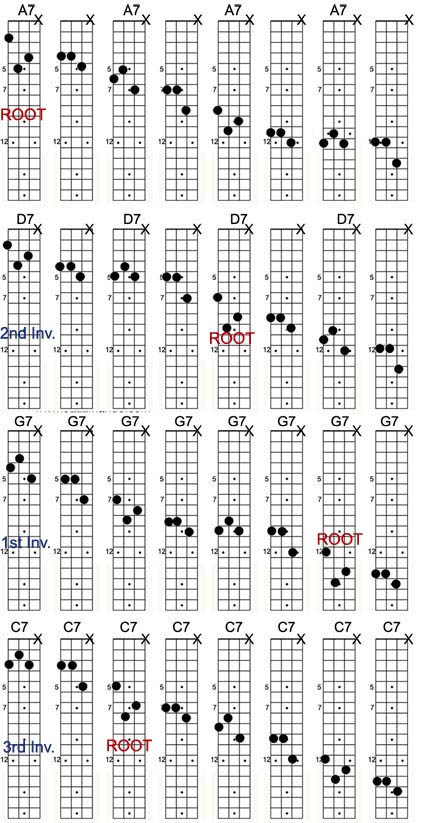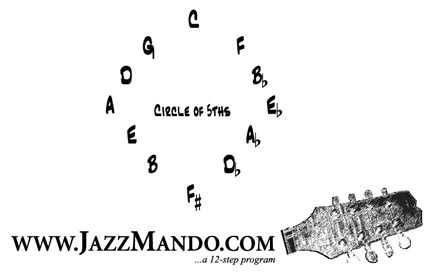« 7th Chord Streams |
Main
| Minor 7th Chord Streams »
 November 1, 2012 | 7th Chord Streams. Under the hood. November 1, 2012 | 7th Chord Streams. Under the hood.
We presented some up-the-neck chord patterns last week that should put you down the path of making some very interesting variations on the V7 chord. We wanted you to just play, listen to the sound and get the variations into your fingers, and went so far as to encourage you to not dig too deep into the theoretical nature of the chords.
Admit it. They just sound sophisticated and cool.
This time, we actually do want to lift up the hood and check out the powerful engine underneath. Maybe you've already figured some of these things out, and if you're ahead of the game. Either way, you can still enjoy just playing.
Let's put on the lab coat. Fellow theory geeks, time to don your glasses held together with athletic tape.

Repeatable Inversions
On each line the 7th chords are four different inversions of the same chord. In traditional music theory, chords are identified by what's in the bass (lowest sounding pitch) of each chord. A Root position chord has the root, a 1st inversion has the 3rd, 2nd inversion has the 5th, and the 3rd inversion has the 7th. In the key of A (A, C#, E, G):
Root = A in bass
1st inversion = C# in bass
2nd inversion = E in bass
3rd inversion = G in bass
Notice in the first line the above inversions are listed in order. In the subsequent D7, G7, and C7 lines, the order ascends the same, it just starts on a different inversion. We've indicated the starting inversion with blue, and each root chord is indicated red.
The point is not to make you learn four different labels, however. The goal is for you to simply know there are four ways to play the V7 chord.
Connecting vs. Prep
On the first line, the alternating chord block between each V7 chord is based on 3 of 4 notes B, D, F#, A, either a Bm7 or a D6 chord. It doesn't really matter what you call it, because the function is the same. It's either just a simple connecting chord, a diatonic path to the V7, or it's a Dominant Prep chord. In our tonal universe, this chord sets up the dominant. It's not a Tonic. It's not a Dominant. It's simply a chord that "prepares" for the Dominant (V7).
What you label it doesn't matter, which is why we don't want to get too hung up on anything other than it's function. It prepares or connects. It stays in the chord's key.
Circle of 5ths
We were intentional in listing the chord lines in this way. A7, D7, G7, C7. They are ordered by the Circle of 5ths. Each chord is the V7 of the next chord. It progresses to the next in a circle that could literally go on infinitely if you continued in 5ths, and ended up where you started. We'd encourage you to immediately figure out for yourself the next in the sequence. Go on with the F7, Bb7, Eb7, Ab7, etc.

This is a practical tool in your chord arsenal. This is the bridge to Charlie Parker's "Scrapple from the Apple." It's also the progression for "I've Got Rhythm," and for that matter, any of the myriad of tunes based on "Rhythm Changes ."
Blues
We mentioned this last week, the 12 bar blues in its three chord simplicity can be supercharged with these progressions. A7, D7, G7, you've got the accompaniment for D blues right there. Use this for Miles Davis "All Blues."
Understand if you take the four chords we've already written, move them up a fret, then down a fret, you've learned them in all 12 keys. Don't worry about what the inversion is, just start learning the relationships between the chords.
We've reduced the exercise to a two page PDF:  7th Chord Streams 7th Chord Streams
Enjoy!
Further
Functional thinking
Jazz Primer: Harmonic Function
Vamps Pt 3. Scurry Dominants
Connecting Chords
Rhythm Changes :
Posted by Ted at November 1, 2012 1:38 PM

Disclaimer: In the 'Information Age' of the 21st Century,
any fool with a computer, a modem, and an idea can
become a self-professed 'expert." This site does not
come equipped with 'discernment.'
|



